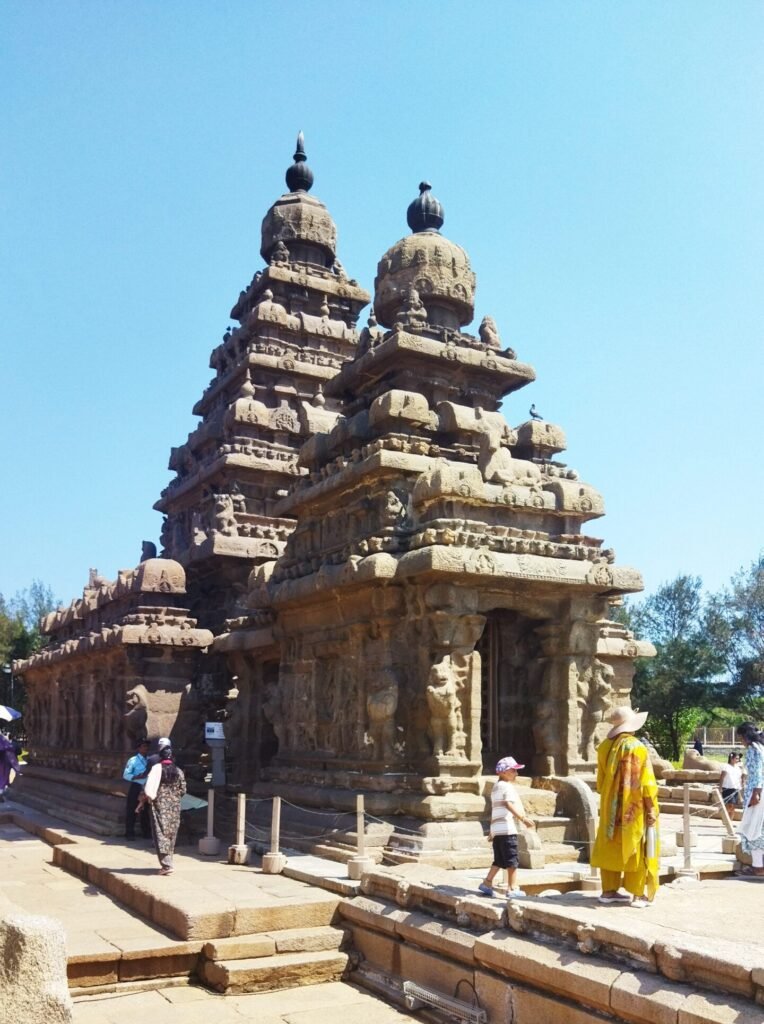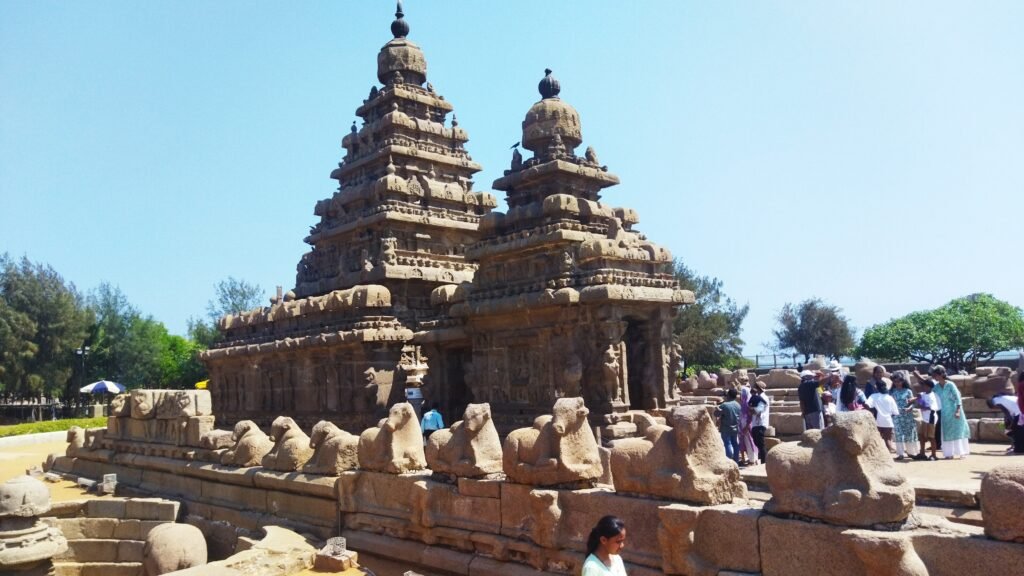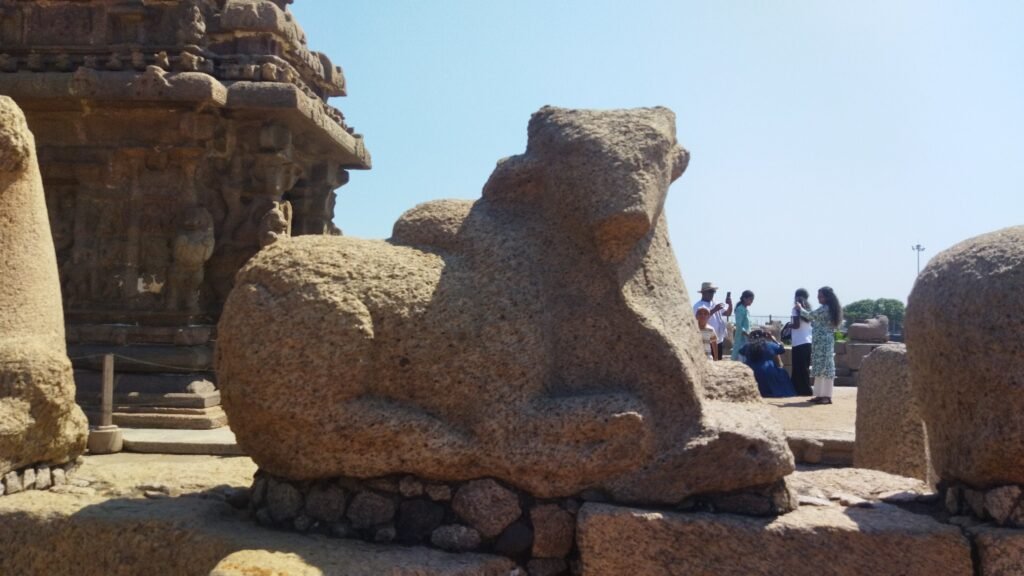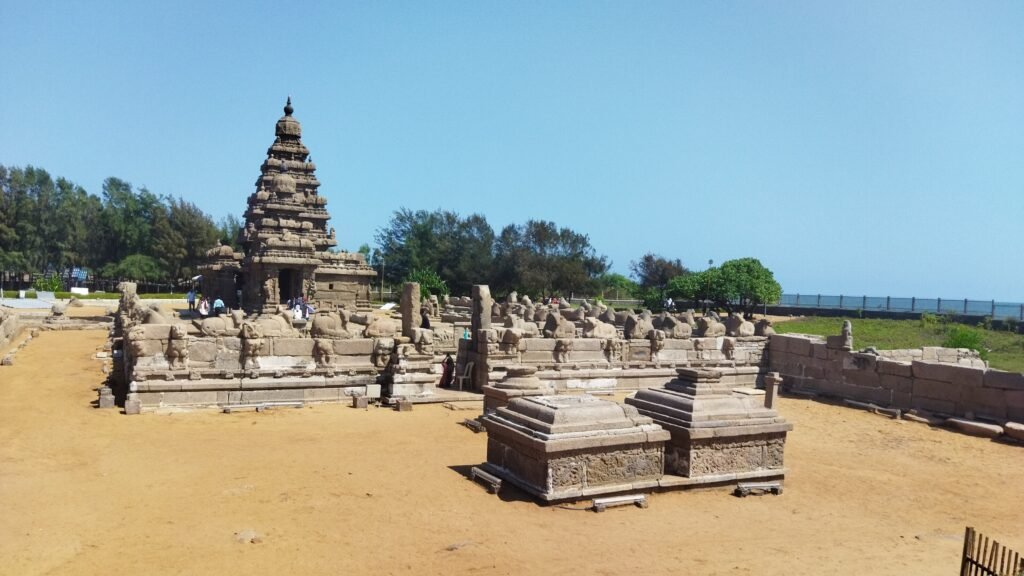Abstract
The Shore Temple at Mahabalipuram, Tamil Nadu, built during the Pallava dynasty in the early 8th century CE, is one of the earliest structural stone temples in South India. As an architectonic landmark overlooking the Bay of Bengal, it represents a transition from rock-cut to structural temple architecture. This article examines the history, planning principles, architectural features, and cultural significance of the Shore Temple, situating it within the broader framework of Dravidian temple architecture and UNESCO’s World Heritage conservation.

Introduction
The Shore Temple, located at Mahabalipuram (Mamallapuram), is an integral part of the Pallava dynasty’s artistic legacy. Unlike earlier rock-cut monuments of the region, this temple complex marks the shift to structural granite construction, reflecting both experimentation and refinement in early medieval South Indian temple design. Today, the temple is recognized as a UNESCO World Heritage Site and remains a cultural, historical, and architectural beacon of the Dravidian style.

Historical Context
Commissioned by King Narasimhavarman II Rajasimha (700–728 CE) of the Pallava dynasty, the Shore Temple stands as a culmination of architectural progress achieved at Mahabalipuram. Earlier Pallava monuments were primarily rock-cut cave temples and monolithic rathas (chariots), carved directly from granite outcrops. The Shore Temple, however, employed dressed stone blocks in a structural system, a major innovation that later influenced Chola and subsequent temple traditions.
Mahabalipuram was an active seaport during Pallava rule, and the temple’s seafront location also suggests its dual role as a religious center and a maritime landmark for sailors.
Planning and Layout
The Shore Temple complex consists of three shrines arranged in a linear east–west orientation:
- The main shrine, dedicated to Shiva (Kailasanatha), faces east to greet the rising sun.
- A smaller Shiva shrine lies parallel behind it.
- A third shrine, dedicated to Vishnu, lies perpendicular, housing the reclining form of Lord Vishnu.
This arrangement makes the Shore Temple unique as one of the earliest examples of combined Shaiva and Vaishnava iconography within a single complex.
The temple precinct is defined by an enclosure wall adorned with rows of seated Nandi sculptures. The axial approach, rhythmic repetition of shrines, and placement in relation to the sea demonstrate an understanding of both ritual alignment and urban-marine context.
Architectural Features
The Shore Temple exemplifies early Dravidian architectural vocabulary, yet retains Pallava experimentation:
- Material: Constructed with locally quarried granite blocks, the temple faces challenges of salt-laden winds, yet its enduring form testifies to Pallava craftsmanship.
- Shikhara (Vimana): The pyramidal tower rises in stepped tiers capped with a rounded finial (stupi), establishing the vertical silhouette characteristic of Dravidian temples.
- Mandapa: The assembly halls (mandapas) are relatively simple, lacking elaborate ornamentation, yet they anticipate the later spacious pillared halls of Chola temples.
- Sculptural Reliefs: Depictions of Somaskanda (Shiva with Parvati and Skanda), Durga, and Vishnu enhance the sanctity of the site. Sculptures are stylistically restrained but monumental, reflecting a transitional aesthetic.
- Water Tank: Archaeological remains suggest the presence of a temple tank, linking ritual purity to architectural planning.

Symbolism and Importance
The Shore Temple holds multi-dimensional importance:
- Architectural Transition: It marks the shift from rock-cut experimentation to structural stone temples, influencing later South Indian temple traditions.
- Maritime Landmark: Serving as a visual beacon for ancient sailors, it emphasizes the integration of religious symbolism with functional seafaring geography.
- Syncretic Iconography: Housing shrines for both Shiva and Vishnu, it demonstrates religious inclusivity within the Pallava tradition.
- Cultural Heritage: Its inclusion in the UNESCO World Heritage List underscores global recognition of its value to world civilization.
- Conservation Challenges: Positioned on the coast, the temple faces constant erosion and salt damage, highlighting the need for ongoing conservation as part of India’s architectural heritage management.

From an architectural perspective, the Shore Temple at Mahabalipuram stands not only as a monument of devotion but as a prototype in the evolution of Dravidian structural temples. Its planning integrates ritual, cosmic orientation, and maritime significance, while its architectural features represent Pallava innovation that laid the foundation for later South Indian temple grandeur. As an architectural historian and practicing architect, one recognizes the Shore Temple as a living dialogue between stone, sea, and spirituality, a dialogue that continues to inspire preservation and scholarly inquiry.
